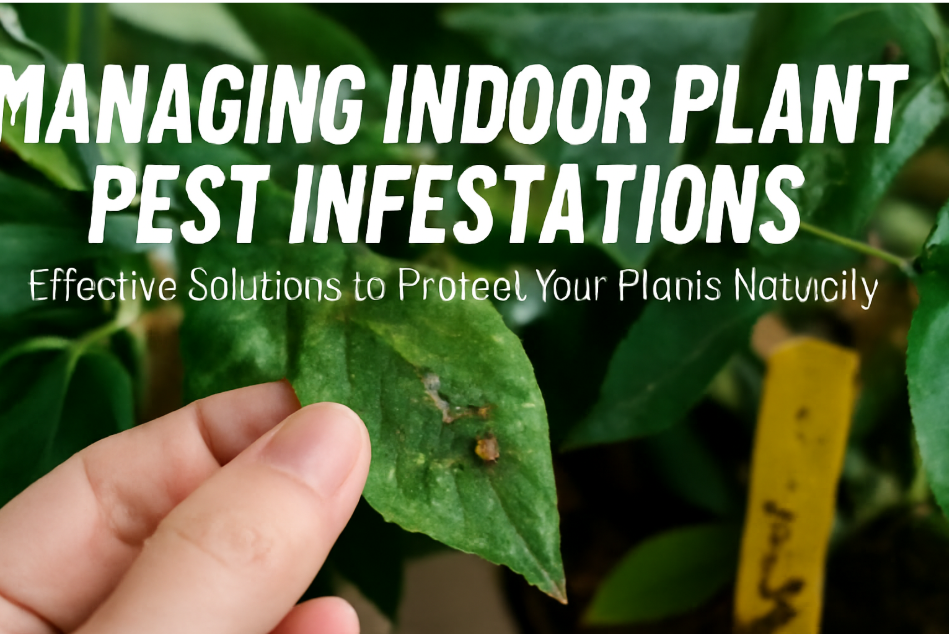
Managing Indoor Plant Pest Infestations: Effective Solutions to Protect Your Plants Naturally
There’s nothing more frustrating than watching your beloved indoor plants struggle under the attack of pests. Whether it’s tiny spider mites weaving webs or aphids feasting on your leaves, indoor plant pest infestations can quickly spiral out of control, causing stress and damage to your greenery. 
In this guide, we’ll dive into effective, natural solutions for managing indoor plant pest infestations. You’ll learn how to spot the signs early, tackle pests with non-toxic methods, and protect your plants without harsh chemicals. With just a few simple steps, you’ll gain the confidence to keep your indoor garden healthy and thriving. So, if you’re ready to reclaim your plants from pests and bring back their natural beauty, keep reading!
Table of Contents
Toggle1. Understanding Indoor Plant Pests
Indoor plants can be a wonderful addition to your home,but they’re also a magnet for pests. If you’ve noticed yellowing leaves, sticky spots, or tiny bugs crawling on your plants, it’s likely that a pest infestation is to blame. But before you panic, let’s break down the types of pests you might encounter and why your plants are at risk.
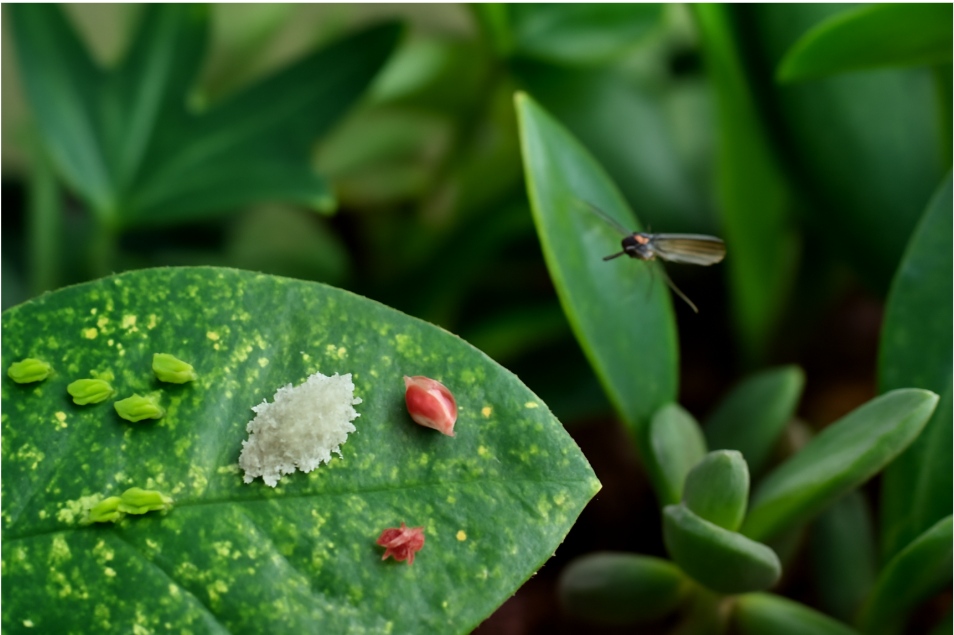
Common Types of Indoor Plant Pests
- Aphids
These tiny, soft-bodied insects suck the sap from plants, causing leaves to curl, yellow, and sometimes drop off. They’re usually green, black, or even white and often gather in clusters on new growth or the underside of leaves. - Spider Mites
Spider mites are tiny, almost invisible to the naked eye. They create fine webbing and leave behind stippling damage on leaves. If you see webbing on your plants or notice your plants becoming pale or speckled, spider mites are likely the culprits. - Mealybugs
Mealybugs are small, white, and fuzzy-looking pests that cluster in crevices, where they suck the sap from plants. These pests are particularly common on houseplants with thicker, fleshy leaves, like succulents. - Fungus Gnats
Fungus gnats are more of a nuisance than a threat. These tiny flies tend to hover around the soil, especially in overly moist conditions. While the adult flies don’t cause harm, their larvae can damage plant roots if the infestation is severe. - Scale Insects
Scale insects look like small bumps or scales on your plant’s leaves or stems. While they’re hard to spot, they can weaken plants by feeding on their sap. Some scales produce a sticky substance called honeydew, which can attract other pests like ants.
Why Are Indoor Plants Vulnerable to Pests?
Unlike outdoor plants, indoor plants don’t have natural predators like ladybugs or birds to help control pest populations. Plus, the warm, humid environment indoors is perfect for pests to thrive. Indoor plants also tend to be placed close together, allowing pests to spread quickly from one plant to another.
Signs of an Infestation
To catch pests early, look out for these common signs:
- Yellowing or curling leaves
- Tiny insects on leaves, stems, or soil
- Sticky residue (often from aphids or mealybugs)
- Webbing (a sign of spider mites)
- Black mold or sooty patches on leaves
The sooner you identify these issues, the easier it will be to manage the infestation before it causes significant damage to your plants.
The Importance of Early Detection
A little prevention goes a long way! Keeping an eye on your plants and spotting pests early can save you time, effort, and potential plant loss. Regular checks, especially under leaves and around the soil, will help you stay on top of things and avoid larger infestations that are harder to control.
2. How to Identify Indoor Plant Pests Early
Early detection is key to managing indoor plant pest infestations. The quicker you spot pests, the easier it is to stop them from causing serious damage. Let’s break down how to identify pests early and prevent your plants from getting overwhelmed.
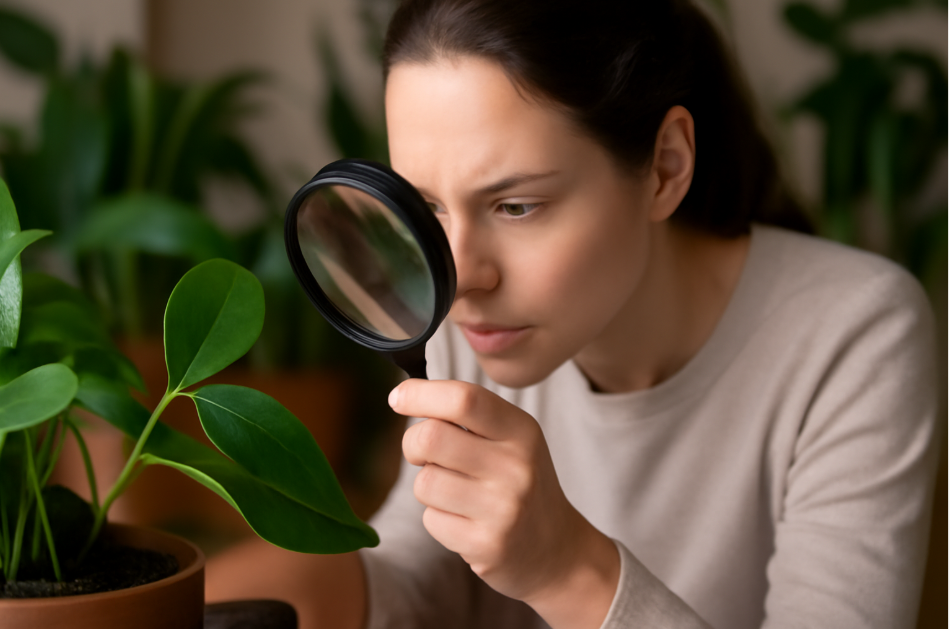
Step 1: Inspect Your Plants Regularly
Regular checks are essential. Set aside a few minutes once a week to carefully examine your plants. Here’s what you should focus on:
- Leaves: Flip the leaves over to check the undersides where pests like to hide.
- Stems and Branches: Look for any signs of pests or damage on stems and along the edges of branches.
- Soil: Check the surface of the soil for tiny bugs or larvae, especially around the edges of the pot.
Step 2: Look for the Most Common Signs of Pests
Here are some typical pest symptoms you can spot with the naked eye:
- Yellowing Leaves or Leaf Damage: If your plant’s leaves are turning yellow or curling, it could be due to pests like aphids or spider mites.
- Sticky Residue (Honeydew): Some pests, like aphids and mealybugs, excrete a sticky substance called honeydew. If you see shiny spots or black mold growing, pests are likely feeding on your plant.
- Webbing: Spider mites leave behind tiny webs, which can be a clear sign that an infestation is brewing.
- Visible Insects: If you spot tiny insects on your plant, identify them quickly. Aphids are often green or black, while mealybugs look white and fuzzy.
- Tiny Holes in Leaves: Holes or chewed edges on your plant’s leaves are another sign of pest activity.
Step 3: Use a Magnifying Glass for Close Inspection
Some pests, like spider mites and thrips, are very small and may be hard to see with the naked eye. Using a magnifying glass can help you spot these tiny invaders on your plants. Look closely at the undersides of leaves or around the joints where the stem meets the leaf. If you notice any tiny insects crawling around, you’ve caught the infestation early.
Step 4: Monitor Plant Health Over Time
Pay attention to any changes in your plant’s health. If your plant has suddenly stopped growing, is showing signs of distress (yellowing, wilting, etc.), or you notice a sudden increase in pests, it’s time to investigate further. Sometimes, pest damage can be subtle, so consistently monitoring your plants will help you catch small problems before they grow into bigger ones.
3. Natural and Effective Solutions for Managing Indoor Plant Pests
Now that you’ve identified the pests on your plants, it’s time to take action! Thankfully, there are plenty of natural and safe solutions that can help you tackle indoor plant pest infestations without resorting to harsh chemicals. 
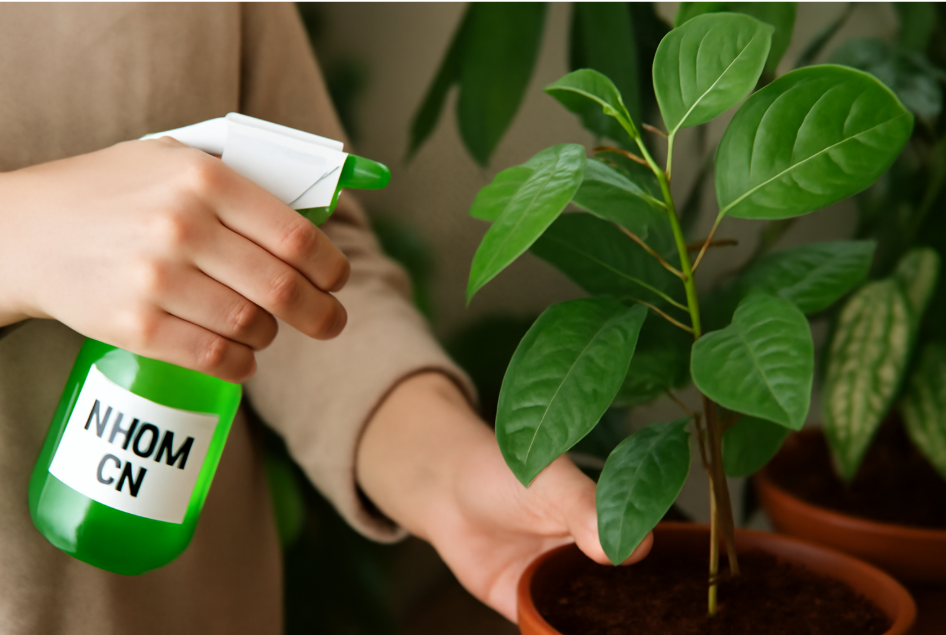
1. Manual Removal: A Simple First Step
When dealing with small infestations, manual removal is one of the quickest and safest ways to get rid of pests. Gently remove visible pests by hand using a cotton swab or by tapping the plant over a sheet of paper to dislodge them. For pests like aphids or mealybugs, you can use a small brush or even a damp cloth to wipe them away. This method works best for light infestations or when you catch pests early.
2. Neem Oil: Your All-Natural Pest Fighter
Neem oil is a natural insecticide that works wonders for indoor plants. It’s safe for most plants and helps to repel or kill pests like aphids, spider mites, and mealybugs. Here’s how to use it:
- How to Make It: Mix 1-2 teaspoons of neem oil with 1 quart (about 1 liter) of water and add a few drops of mild dish soap (to help the oil mix with water).
- Application: Spray the solution on affected plants, covering both the tops and bottoms of the leaves. For stubborn pests, repeat every 7-10 days until the infestation is under control.
3. Insecticidal Soap: A Simple DIY Solution
Insecticidal soap is another great option for naturally controlling pests. It works by suffocating the insects and disrupting their cell membranes. You can either buy pre-made insecticidal soap or make your own at home. Here’s how:
- DIY Recipe: Mix 1 tablespoon of mild liquid dish soap with 1 quart of water.
- Application: Spray it directly onto pests, especially on the undersides of leaves. Avoid using it in direct sunlight to prevent plant burn.
4. Beneficial Insects: Nature’s Helpers
Introducing beneficial insects to your indoor garden is an effective, eco-friendly way to manage pests. Ladybugs, predatory mites, and lacewing larvae are natural predators that feed on common plant pests like aphids, spider mites, and whiteflies.
- How to Use Them: You can purchase these beneficial insects online or at garden centers. Release them around your infested plants, and they’ll do the hard work of eating the pests for you.
5. Diatomaceous Earth: A Safe Yet Deadly Solution
Diatomaceous earth (DE) is a fine powder made from the fossilized remains of tiny organisms. It works by dehydrating pests like aphids, ants, and thrips, killing them without harming your plants. DE is non-toxic to humans and pets, but it’s effective against a wide range of pests.
- How to Use It: Lightly dust the surface of the soil and around the base of your plants. For pests like ants, apply DE directly to areas where they are active. Be sure to reapply if it gets wet, as moisture can reduce its effectiveness.
6. Sticky Traps: Catch Those Flying Pests
Sticky traps are a great way to capture flying insects like fungus gnats and whiteflies. These traps are coated with a non-toxic adhesive that attracts pests, trapping them as they fly by.
- Where to Place Them: Hang the traps near the affected plants or place them around the edges of your indoor garden.
- When to Use Them: They’re most effective when pests are just starting to appear or if you notice an uptick in flying insects.
4. Preventing Future Pest Infestations
Once you’ve successfully managed an indoor plant pest infestation, the next step is to prevent it from happening again. Preventing future pests not only protects your plants but also saves you time and effort. Let’s look at some simple yet effective ways to keep your plants pest-free.

1. Keep Your Plants Healthy
Healthy plants are less likely to attract pests. A well-maintained plant has stronger defenses against pest invasions. Here’s how you can promote plant health:
- Proper Watering: Avoid over-watering, as damp conditions attract pests like fungus gnats. Ensure that your pots have good drainage, and let the soil dry out between waterings.
- Adequate Light: Make sure your plants are getting the right amount of sunlight for their specific needs. Too little light can stress plants, making them more vulnerable to pests.
- Fertilization: Use organic fertilizers to keep your plants strong and nourished. Well-fed plants are better equipped to fight off pest problems.
2. Quarantine New Plants
Bringing new plants into your home can introduce pests to your entire indoor garden. To avoid this, quarantine any new plant for at least 2-3 weeks before introducing it to your other plants. During this time, inspect it closely for pests or signs of infestations.
3. Maintain a Clean Environment
A clean growing environment is essential for preventing pests. Here’s how to keep things tidy:
- Clean Pots and Trays: Regularly clean the surface of your pots and trays to remove debris and old leaves that pests might use as hiding spots.
- Remove Dead Leaves: Trim away any dead or damaged leaves to discourage pests from taking shelter.
- Disinfect Tools: Clean your gardening tools (like scissors, pruners, or watering cans) regularly to avoid spreading pests between plants.
4. Regular Inspections
It’s important to make plant inspections a routine part of your plant care. Check for pests at least once a week, especially during the growing season. Early detection is key to preventing a full-blown infestation.
5. Rotate Your Plants
If you have multiple plants, rotating their positions every few weeks can help prevent pest infestations. This disrupts the environment, making it harder for pests to settle in one area. It also ensures that all your plants get an even amount of light.
6. Use Natural Pest Repellents
Certain plants naturally repel pests. Consider adding these plants to your indoor garden to act as a natural barrier:
- Lavender repels aphids, moths, and fleas.
- Basil keeps flies and mosquitoes at bay.
- Mint can deter ants and spiders.
5. When to Seek Professional Help
While most indoor plant pest infestations can be managed with natural solutions, there are times when professional help is necessary. If you’ve tried everything and your plants are still struggling, it may be time to call in the experts. Here’s when you should consider seeking professional pest control assistance.
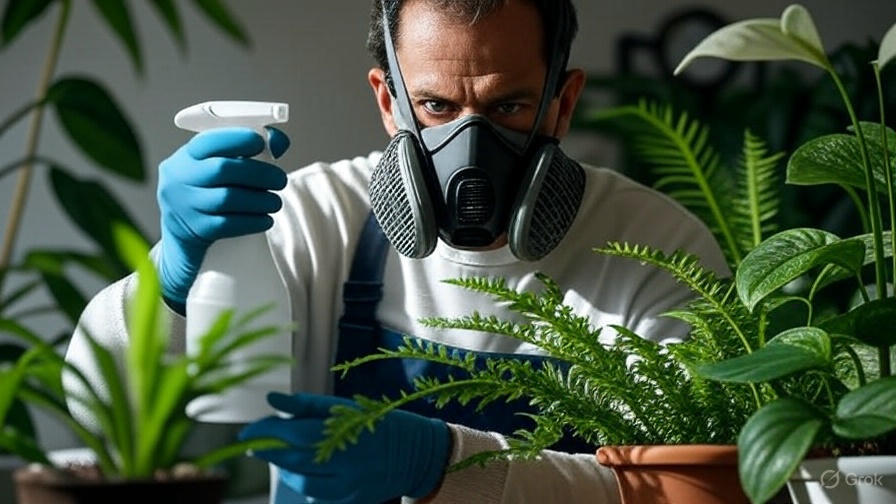
1. Severe Infestations
If your plants are heavily infested and natural remedies aren’t doing the trick, a professional pest control service may be your best option. A severe infestation can cause long-term damage to your plants, and trying to manage it on your own can be overwhelming. If you notice widespread damage or pests spreading to multiple plants, it’s time to get help.
2. Persistent or Unidentified Pests
Sometimes, pests are tough to identify, or they may be resistant to common treatments. If you’re dealing with a persistent pest problem that doesn’t seem to go away despite your efforts, a pest control expert can accurately identify the issue and recommend targeted treatments. Professionals often have access to more advanced treatments that are safe for your plants but more effective against stubborn pests.
3. Damage Beyond Repair
If the pest damage has become too severe—leaves are wilting, roots are destroyed, or your plants are dying—it may be too late for home remedies. A professional can help assess the damage and offer solutions that could potentially save your plants or prevent further spread. They may also recommend which plants are salvageable or need to be removed to protect the rest of your garden.
4. When You’re Not Comfortable Handling Pesticides
If the infestation is severe enough that chemical treatments are needed, it’s often safer to leave this to the professionals. While many pesticides are effective, they can also be harmful to humans, pets, and the environment if not used correctly. If you’re not comfortable using chemicals, or if you’re unsure which products are safe for your indoor space, a pest control expert can handle this for you.
5. If You’re Dealing with Multiple Plants or a Larger Garden
For those with larger indoor gardens or multiple plants that are infected, professional help can be an efficient and effective way to manage pest control. The more plants you have, the more difficult it becomes to monitor and treat each one. A pest control expert can treat your plants in bulk, ensuring a comprehensive solution.
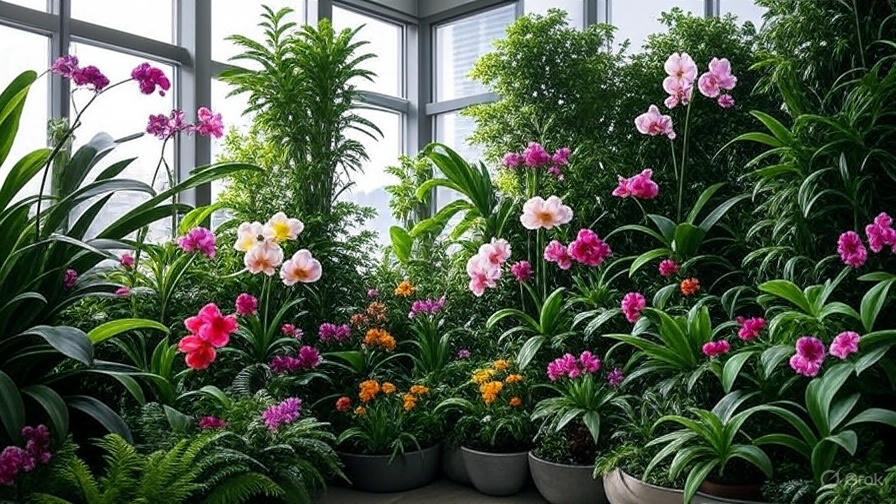
Managing indoor plant pest infestations doesn’t have to be a daunting task. By understanding the pests that threaten your plants and using natural, safe solutions, you can protect your indoor garden without relying on harsh chemicals. 
Remember, early detection is key—catching pests early allows you to take quick action before they cause major damage. If the infestation becomes too overwhelming, don’t hesitate to seek professional help. With a little care and attention, you can ensure your indoor plants thrive for years to come.
Now that you’re equipped with the knowledge to manage and prevent pest infestations, it’s time to get back to enjoying your beautiful, thriving indoor garden! Happy gardening!
FAQs on Managing Indoor Plant Pest Infestations
1. How can I tell if my indoor plants have pests?
Look for signs like yellowing leaves, sticky residue, tiny holes in leaves, webbing, or visible bugs on your plants. Regularly inspect the undersides of leaves and soil for pests like aphids, spider mites, and fungus gnats. Early detection is key to stopping infestations before they get out of hand. 👀
2. What are the best natural ways to get rid of pests on indoor plants?
Neem oil and insecticidal soap are great natural options for tackling indoor plant pests. Both are non-toxic and effective against a range of pests like aphids, mealybugs, and spider mites. You can also try introducing beneficial insects like ladybugs to help control pest populations naturally.
3. Are there any plants that help keep pests away?
Yes! Plants like lavender, basil, and mint naturally repel pests like aphids, mosquitoes, and ants. Consider adding these plants to your indoor garden as a natural barrier against unwanted pests. 🌿
4. How often should I check my indoor plants for pests?
It’s a good idea to inspect your plants weekly, especially during the growing season. This allows you to catch any pests early before they cause significant damage. Make sure to check the undersides of leaves and around the soil for signs of pests. 🔍
5. Can pests harm my pets or children?
Most common indoor plant pests, like aphids and spider mites, are harmless to pets and children. However, some pest control treatments, such as chemical pesticides, can be harmful. Always opt for natural, non-toxic solutions to keep both your plants and loved ones safe. 🐾
6. What is the fastest way to get rid of pests on indoor plants?
For a quick fix, try spraying your plants with a solution of neem oil or insecticidal soap. These remedies work fast and are effective against most pests. Repeat every 7-10 days if necessary until the infestation is under control. 💨
7. How can I prevent pests from returning to my indoor plants?
To prevent future infestations, regularly clean your plants and their surroundings, inspect them for pests, and quarantine new plants before adding them to your collection. Keeping your plants healthy and maintaining a clean environment also helps discourage pests from settling in. 🌟
8. When should I seek professional help for a pest infestation?
If the infestation is severe, persistent, or you can’t identify the pests, it may be time to call a professional. They have the expertise and tools to handle complex pest problems and prevent further damage to your plants. Don’t hesitate to seek help if your plants are suffering. 🛠️


















